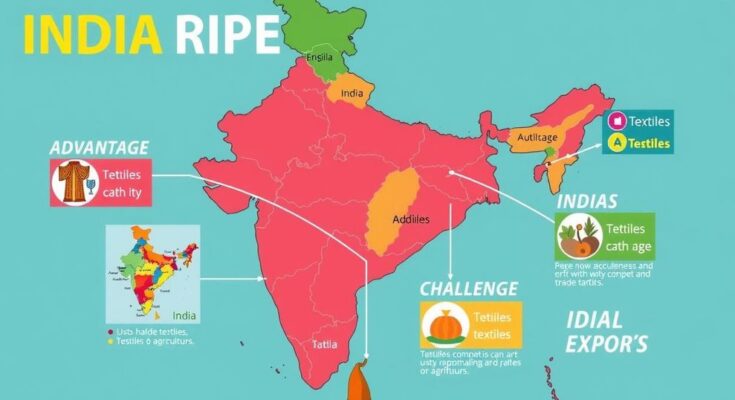India, facing a 27 percent tariff on exports to the United States in 2023, is positioned more favorably than some competitors like China and Vietnam. Key sectors including textiles and gems and jewellery may benefit, while areas such as automobiles and agriculture could suffer. Bilateral trade negotiations may offer opportunities for adjustment.
In 2023, India, being the world’s 12th-largest exporter, is facing significant challenges with a new 27 percent flat tariff on all exports to the United States. This is a considerable hurdle for Indian exporters; however, when compared to nations like China, Vietnam, Bangladesh, and Indonesia, India retains a relatively advantageous position regarding tariff rates.
While China faces a 34 percent tariff and Vietnam encounters a steep 46 percent, other competitors such as Bangladesh and Thailand confront tariffs of 37 percent. Cambodia endures the highest tariff at 49 percent, and Sri Lanka faces 44 percent. India’s relative standing in comparison to these competitors may provide it with subtle advantages in specific sectors.
In the automobile sector, the US has implemented a 25 percent tariff on imported vehicles, which impacts major Asian automobile manufacturers such as Toyota, Honda, and Nissan. India’s auto exports to the US are minimal, constituting only 0.13 percent (passenger vehicles) and 3 percent (commercial vehicles) of total auto exports. Tata Motors may experience indirect effects via Jaguar Land Rover, which derives about 23 percent of its revenue from the US market.
India’s auto component exports, while totaling $21.2 billion, make up one-third of its industry exports, but represent merely 2 percent of US auto component imports. Comparatively, Mexico, Canada, and China dominate with shares of 39 percent, 13 percent, and 12 percent, respectively. In 2023, less than 0.5 percent of India’s overall car exports were destined for the US, with primary markets being Saudi Arabia, South Africa, and Mexico.
The textile sector may see benefits from the new tariffs, since rivals like Vietnam, Bangladesh, and China are subject to more substantial import duties. For context, the US imposes a 46 percent duty on Vietnamese textiles, 37 percent on Bangladeshi textiles, and 34 percent on Chinese textiles. India captures 8 percent of the US textile import market, representing approximately $9.7 billion, while the sector contributes only 2 percent to India’s GDP.
In the gems and jewellery market, India retains a robust position as a supplier to the US, commanding 12.99 percent of total US imports in this category, equivalent to $11.58 billion. Competing nations’ shares are considerably smaller, confirming India’s dominance despite the new tariffs.
Agricultural exports such as basmati rice, buffalo meat, and wheat are affected by the 27 percent tariff. However, India retains a price advantage over competitors in processed food items, despite also facing stiff competition from Mexico, which benefits from the US-Mexico-Canada Agreement (USMCA) allowing for lower tariffs on compliant goods due to its geographic proximity to the US.
India currently exports $14 billion worth of electronics to the US, with the new tariff elevating costs. Still, India remains in a better position relative to Vietnam and China. Nevertheless, Mexico’s tariff-free status under the USMCA for compliant goods provides an edge, while non-compliant electronics face a 25 percent tariff.
The ongoing negotiations regarding a bilateral trade agreement with the US may offer some relief from these tariffs. Despite the implementation of these new trade barriers, India continues to be better positioned than several key competitors, potentially enhancing its competitiveness in select sectors.
In conclusion, India faces significant challenges due to the new 27 percent tariffs imposed by the United States on its exports. Nonetheless, when comparing tariff rates with major competitors such as China and Vietnam, India maintains a relatively advantageous position. Sectors such as textiles and gems and jewellery may benefit from this tariff structure, while others like automobiles and agriculture may face more hurdles. The potential for a bilateral trade agreement could provide further relief for Indian exporters in the face of these tariffs.
Original Source: www.business-standard.com




